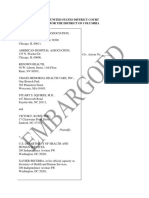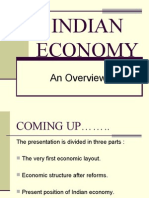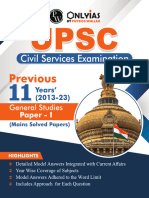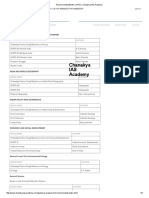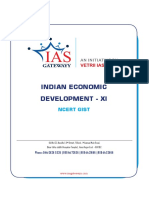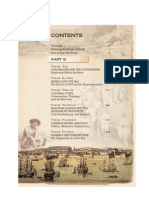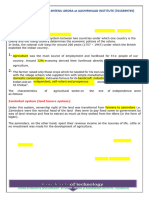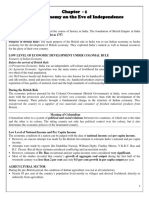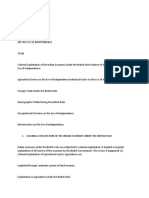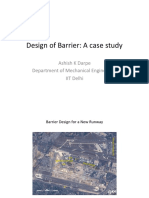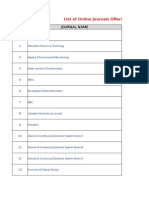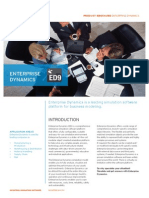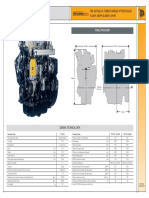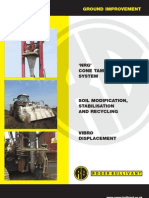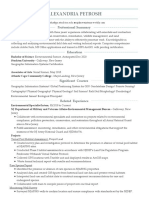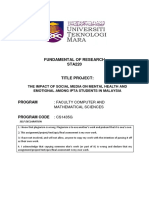Indian Economy On The Eve of Independence
Indian Economy On The Eve of Independence
Uploaded by
zeeshanahmad111Copyright:
Available Formats
Indian Economy On The Eve of Independence
Indian Economy On The Eve of Independence
Uploaded by
zeeshanahmad111Original Title
Copyright
Available Formats
Share this document
Did you find this document useful?
Is this content inappropriate?
Copyright:
Available Formats
Indian Economy On The Eve of Independence
Indian Economy On The Eve of Independence
Uploaded by
zeeshanahmad111Copyright:
Available Formats
Indian Economy on the
eve of Independence
There is no doubt that our grievances against the British Empire had a sound basis. As the
painstaking statistical work of the Cambridge historian Angus Maddison has shown, India's
share of world income collapsed from 22.6% in 1700, almost equal to Europe's share of 23.3%
at that time, to as low as 3.8% in 1952. Indeed, at the beginning of the 20th century, "the
brightest jewel in the British Crown" was the poorest country in the world in terms of per
capita income.
-Manmohan Singh
IIT Delhi
Indian Economy on the eve of Independence
Important indicators of Indian economy in 1950-51
Indicator 1950-51 2011-12
GDP at 1999-00 prices
(Rs crore)
2,23,899 83,62,495
Per Capita NNP (Rs) 5708 38,037
Forex Reserves (US $
million)
1914 2,60,742
Life Expectancy at birth
(years)
32.1 66.1
Taken from Dutt & Sundaram Indian Economy p. 2 whose source is Economic Survey(2012-13)
Indian Economy- caught in a vicious
circle of poverty
Poverty
Low
consumption
& income
Low savings
& capital
formation
Low
productivity
& income
Features of Indian Economy at
Independence
1. Underdeveloped Economy
Low per capita income
Agricultural Economy
In 1948, about 70% of the population was dependent on agriculture which
contributed to 50% of the national income. Per hectare production was very
low
Underdeveloped industries
Basic & heavy industries were very few and productivity was low
Import based economy
Dependence on imports even for consumer goods
Poor infrastructure & human development
Poor quality & network of means of transport & communication and illiteracy
2. Predominance of Agriculture
Agriculture contributed more than 50% of the national income totally in
contrast to the economic structure of developed economies
More than 70% of the population was dependent on agriculture
Huge pressure of population on land
Taken from Uma Kapila, Indian Economy Since Independence p. 33
3. Stagnation of economy
Growth rate of per capita income during British period for almost a century
was less than 0.5%
The high population growth also reduced potential for growth
Main reasons were:
Overdependence on agriculture
Destruction of cottage & handicraft industries
Commercialization of agriculture
Economic drain of wealth to Britain
Discriminatory taxes which made Indian goods costlier
Taken from Jain T.R., Trehan M, Uppal R & Trehan R, Indian Economy p. 5
4. Depreciated Economy
In every economy, extensive use of factors of production leads to their wear &
tear. If these are not replaced, the production capacity falls. Such an
economy is called depreciated economy
During World War II, India supplied huge quantity of goods to Britishers and
was paid for it in terms Sterling. But due to lack of real capital, Indian
economy became depreciated soon after
Extensive use of means of transport during the war led to tremendous
depreciation of railway equipment during the war. This adversely affected
railway traffic
5. Semi-Feudal economy
Neither wholly feudal nor capitalistic, hence semi-feudal
Mixture of the following modes:
Feudalism Zamindari, Ryotwari & Mahalwari systems
Capitalism Capitalistic industries like cotton textile, iron & steel, sugar with large
amounts of foreign investment. Also present was capitalist agriculture like tea,
rubber & coffee plantations
6. Disintegrated Economy due to Partition
Per capita availability of land decreased
India got 82% of the population & 77% of the land
Disadvantage to agriculture While Pakistan became a surplus state in
foodgrains, India faced shortage due to lesser (65%) of the foodgrain area,
irrigation facilities, lesser cotton textile and jute producing areas
Setback to industries 91% of the industries remained in India but due to
shortage of raw materials, India had to import them to feed its industries
Foreign Trade India had to import jute, cotton etc. from outside causing
uncertain supply of raw materials
7. Income Disparities
A part of the high income inequality in India around the time of independence
was caused by very high incomes of the British in India
0.06% of the total population (British officials & businessmen) received 5% of
the total income (Madison, 2002)
Even after the departure of the British, income inequalities remained high
The main reason is the very low income level of the poor classes
Taken from Branko Milanovic, Peter H Lindert & Jeffery G Williamson, Measuring Ancient Inequality p. 56
8. Industrial Backwardness & Capital Deficiency
Deficiency of heavy & basic industries
Low productivity and capacity utilization
Total production of steel in 1947 was just 9 lakh tonnes
Low level of capital formation in India due to
Low inducement to invest
Low propensity & capacity to save
9. Lack of Social Overhead Capital
Social Overhead Capital or infrastructure capital consists of such industries
which help in the growth of other industries
Railways & other means of transport, electricity & other sources of power,
banking, communication etc.
The British designed these so as to serve their own interests without paying
attention to their role in development of Indian economy
10. Low Standards of Living
The standard of living among the peasant class which formed a huge part of
the population was very low
Famines continued to occur regularly in the country during the British period
The 1943 Bengal famine shook the foundations of the country
One of the main causes of the famines was the lack of purchasing power
among the peasants and related classes
Large number of people were unemployed as sufficient jobs were not created
to accommodate the growing population
Economic consequences of British
conquest
Indeed some kind of chart might be drawn up to indicate the close connection
between length of British rule and progressive growth of poverty. That rule began
with outright plunder, and a land revenue system which extracted the uttermost
farthing not only from the living but also from the dead cultivators. It was pure
loot.
-Jawaharlal Nehru
Economic consequences of British
conquest
Decline of Indian handicrafts and progressive ruralisation
Land systems (1793 1850)
Commercialization of Agriculture
Process of industrial transition in India
Colonial exploitation
Decline of Indian handicrafts and progressive
ruralisation
Attempts to restrict and crush Indian manufacturers
Disappearance of princely courts resulting in industries losing patronage
Competition of machine-made goods with handicraft-goods
Development of new forms and patterns of demand as a result of foreign
influence
Destruction of industries resulting in unemployed craftsmen moving
towards agriculture (Deindustrialization)
Introduced in Bengal and
neighboring areas. This settlement
raised status of revenue collectors
to that of private landlords.
Land systems
(1793 1850)
Zamindari Ryotwari
Evolved for large parts of
Bombay and Madras and
extended to north-eastern and
north-western India. This
settlement made each peasant
landlord of their own land and
peasant was directly responsible
to the state for annual payment
of land revenue.
Commercialization of
Agriculture(1850-1947)
Commercialization of agriculture implies production of crops for sale rather
than for family production.
Industrial revolution in Europe increased demands for raw materials.
British induced peasants for commercial crops by paying them more.
At the same time, introduction of railways networks enhanced
commercialization.
This led to fall in production of food to consume.
Consequently this period is also marked by occurrence of most terrible
famines.
Establishment of first cotton-
mill, jute mill and first coal
mine.
Establishment of railway
network
By end of 19
th
century there
were 194 cotton-mills and 36
jute mills and coal production
had risen to 6 million tonnes
per annum.
Process of industrial
transition in India
Industrial growth
during 19
th
century
Industrial
progress during
20
th
century
In 1905, SWADESHI movement
stimulated Indian industries.
First world war created great
demands for factory goods, which
increased the production of iron and
steel, jute, leather goods, cotton
etc.
In 1924, government of India gave
protection to selected Indian
industries against foreign
competition.
Colonial exploitation
Exploitation through trade policies
Forcing cultivators to cultivate and sell Indigo plant at a very low price
Forcing artisans through company agents to sign bonds to deliver a certain quantity of
goods at a price fixed by the Gomasta.
Exploitation through manipulating import-export duties:-
After 1700, imports of Indian printed cotton fabrics in England were banned.
Heavy import duties were imposed on Indian goods, other than foodstuff and raw materials
imported from India and very nominal duty on imports of British manufacturers into India.
Discriminating protection whittled down by the clause of imperial preference
Exploitation through export of British capital to India
Exploitation through finance capital via the managing agency system
Consequences of exploitation
India remained primarily an agriculture country and its agriculture became
commercialized.
Handicrafts destroyed and India became an importer of manufactured goods.
Policy of discriminating protection along with imperial preference gave British
complete control over the India market.
British developed economic infrastructure in the form of railways and
irrigation and electricity works with a view to promote foreign trade but no
effort was made to develop heavy and basic industries.
Managing agency system did help to promote consumer goods industries in the
initial phase, but exploitative in character later.
British exploited India through the economic drain via the home charges.
A Brief look at Union Budget 1947-48
BUDGET OF NEWLY FORMED INDIA
Announced by SHRI R.K. SHANMUKHAM CHETTY, Finance minister
Covers a period of 7 month from 15
th
Aaugust,1947 to 31
st
March,1948
Necessity to present a budget
Problems
arising out of
the partition
Economic
Situation in
the country
Decline in agricultural
and industrial production
Bad food position, had to
import a large amount of
food, causing flow of currency
Economic consequences
arising out of these
disturbances in Punjab and
North-West frontier provinces
Arrangement for coins
and currencies
Division of assets and
liabilities
Transfer of staff and
organizations
There remained some issues that could not be settled very easily and
hurriedly so arbitral Tribunal and Joint Defense Council was set up to
look at some issues that were left for further consideration.
Issues handled by Arbitral tribunal :
Allocation of debt between the two Dominions
the method of discharging the pensionary liability
the valuation of the Railways
the division of the assets of the Reserve Bank
Issues handled by Joint Defence council:
To reconstitute the Armed Forces between the two Dominions
To allocate the military stores, equipment and installations between them
Decisions taken under fiscal and
economic relation
Economy
Trade
Common
Currency
System
Equal contribution
Coordinatio
n
Revenue
Budgeted revenue was Rs. 171.15 crores-
This includes 50.5 crores from custom receipt, 29.5 crores from
income tax, 80.5 crores from ordinary collections.
Revenues from posts and telegraph was 15.9 crores and their
working expenses was 13.9 crores leaving a net surplus of 2 crores
Rebate of interest on its share of the accumulated profits in the
past was 71 crores
Revenue expenditure was Rs. 197.39 crores
Defense services accounts for 92.74 crores
22 crores for expenditure on the evacuation, relief and rehabilitation
of refugees from Western Pakistan.
Liabilities on Indian Government
Outstanding debt of the late Central Government and the pensions chargeable
subsidies on
imported
food grains
evacuation,
relief and
rehabilitation
of refugees
from Western
Pakistan
nation
building
activities
such as
education,
medical,
public health
includes loans
Means to Revive Economy
Started issuing loans at two percent
But, a small time later there was strong criticism as there were
flaws in monetary policies:
Considered to be a cheap money policy
No absolute criterion to judge propriety of rates at which
govt. borrow in market
Question of keeping a balance between industry and
government demand such that funds are utilized in best way
Steps to overcome loan problem
1. Programs to obtain the funds required by Government as
cheaply as possible
2. Reorganize small saving movements, undertaking large
schemes of development
Sterling balance
Govt. tried to reduce the outflow of currency
Govt. aims that reserves to be used for purchasing capital goods not to finance deficits
Decided to adopt restrictive import policy(excluding certain essential items)
After all these adoptions govt. was able to credit their current account successfully
YEAR Earned
( in dollars)
Spent
(in dollars)
Net
Deficit/surplus
1939-1946 405 crores 240 crores + 165 crores
1946-1947 83 crores 98 crores - 15 crores
Taken from R.K. Shanmukham Chetty Speech (Minister of Finance), Union Budget 1947-48
Deficit and General final position
DEFICIT
Mostly covered by additional taxation
Increase existing export duties
To say exactly is not easy as it fluctuates with the changing expenditure and
revenue
POSITION
relatively small burden of unproductive debt and almost negligible external
debt
persistence of inflationary trends and the unsatisfactory food position
level of taxation has badly affected incentive for investment
References
Datt, Gaurav & Mahajan, Ashwini, Datt and Sundaram Indian Economy
Jain T.R., Trehan M, Uppal R & Trehan R, Indian Economy
Branko Milanovic, Peter H Lindert & Jeffery G Williamson, Measuring Ancient
Inequality
Kapila, Uma, Indian Economy Since Independence
R.K. Shanmukham Chetty Speech (Minister of Finance), Union Budget 1947-48
You might also like
- AMA and AHA - Complaint 12 9 2021 Embargoed VersionDocument29 pagesAMA and AHA - Complaint 12 9 2021 Embargoed VersionPeter SullivanNo ratings yet
- Section ADocument55 pagesSection AJazz SinNo ratings yet
- Acoustics Wave EquationsDocument27 pagesAcoustics Wave Equationszeeshanahmad111No ratings yet
- Indian Economy: An OverviewDocument46 pagesIndian Economy: An OverviewArpit Srivastava100% (2)
- Marathon Class (Part 1) - Indian Economy For UPSC EPFODocument41 pagesMarathon Class (Part 1) - Indian Economy For UPSC EPFOdiwakarj7_310135942No ratings yet
- 77-Indian Economy and Policy BookDocument274 pages77-Indian Economy and Policy BookVinay landgeNo ratings yet
- Challenge of Indian EconomyDocument11 pagesChallenge of Indian EconomyPrabhu VelidindiNo ratings yet
- Cheat Sheets Compilation ARVINDDocument55 pagesCheat Sheets Compilation ARVINDFighterspiritNo ratings yet
- Deco502 Indian Economic Policy English PDFDocument386 pagesDeco502 Indian Economic Policy English PDFAditya ShrivastavaNo ratings yet
- Poverty and EmploymentDocument32 pagesPoverty and EmploymentVikrant SinghNo ratings yet
- Economy Kalam Golden Pages (KGP 2024)Document42 pagesEconomy Kalam Golden Pages (KGP 2024)Akash NawinNo ratings yet
- (Jagaran Josh) Indian Economy and Basic EconomicsDocument239 pages(Jagaran Josh) Indian Economy and Basic Economicsshashankniec100% (1)
- Lesson 19 - Revolt of 1857 Lyst5240Document16 pagesLesson 19 - Revolt of 1857 Lyst5240Deepak ShahNo ratings yet
- History Class 7-8 PPTSDocument73 pagesHistory Class 7-8 PPTSreddyNo ratings yet
- Structure of The Indian EconomyDocument16 pagesStructure of The Indian EconomyAmbalika Smiti100% (9)
- Lesson 6 Extremist Phase of Nationalist StruggleDocument22 pagesLesson 6 Extremist Phase of Nationalist StruggleDeepak ShahNo ratings yet
- Lesson 27 - Socio-Religious Movements 18-19 Century Lyst9751Document28 pagesLesson 27 - Socio-Religious Movements 18-19 Century Lyst9751Deepak ShahNo ratings yet
- Ied Case StudyDocument51 pagesIed Case StudyTishaNo ratings yet
- Modern History Notes English Bpscians Bihar SampurnaDocument240 pagesModern History Notes English Bpscians Bihar Sampurnaaadharshkumar2013No ratings yet
- Social Science Class 10 Understanding Economic DevelopmentDocument93 pagesSocial Science Class 10 Understanding Economic DevelopmentkannansesNo ratings yet
- India Social Issues & Welfare SchemesDocument46 pagesIndia Social Issues & Welfare SchemesAbhishek GoyalNo ratings yet
- Ncert XII Political Science Democracy India Old SyllabusDocument141 pagesNcert XII Political Science Democracy India Old SyllabusNikunj AgarwalNo ratings yet
- 01Document27 pages01DDNo ratings yet
- CBSE Class 12 Geography Revision Notes Chapter 11Document4 pagesCBSE Class 12 Geography Revision Notes Chapter 11Satyam Mishra100% (1)
- 2-Polity by DR Sidharth Arora - 2-PreambleDocument123 pages2-Polity by DR Sidharth Arora - 2-PreambleNishant SinghNo ratings yet
- Pyq Mains GS1 (English)Document240 pagesPyq Mains GS1 (English)pulkitsingla68No ratings yet
- Mains Internal-Security PDFDocument35 pagesMains Internal-Security PDFSnigdhaNo ratings yet
- Modern History of Bihar 41 PDFDocument21 pagesModern History of Bihar 41 PDFHago KrNo ratings yet
- Structure of Indian Economy at The Eve of IndependenceDocument19 pagesStructure of Indian Economy at The Eve of IndependenceRohit Kumar100% (1)
- Lesson 17 - British Administration 1757-1857 Lyst8895Document18 pagesLesson 17 - British Administration 1757-1857 Lyst8895Deepak ShahNo ratings yet
- Pyq Essay 1993 2023 PyqDocument15 pagesPyq Essay 1993 2023 Pyqfitnesshunt.777No ratings yet
- UPSC Essentials January 17 2024Document104 pagesUPSC Essentials January 17 2024vijaymmeiiitnNo ratings yet
- Final MnemonicsDocument85 pagesFinal MnemonicskoppadivijayramakrishnaNo ratings yet
- Rau's Mains Compass - 2021 EssayDocument139 pagesRau's Mains Compass - 2021 EssayvenkateshNo ratings yet
- TEST-8: Lesson 2 Growth & DevelopmentDocument58 pagesTEST-8: Lesson 2 Growth & DevelopmentDeepak ShahNo ratings yet
- Recommended Books - UPSC - Chanakya IAS AcademyDocument3 pagesRecommended Books - UPSC - Chanakya IAS AcademySumit GartiaNo ratings yet
- Chapter 3 - Climatology - Geography - Pre Crash Course - 2021 Lyst5228Document46 pagesChapter 3 - Climatology - Geography - Pre Crash Course - 2021 Lyst5228Deepak ShahNo ratings yet
- VISION IAS Society @pdf4exams PDFDocument298 pagesVISION IAS Society @pdf4exams PDFSwati YadavNo ratings yet
- Indian Economic Development - Xi: GatewayyDocument27 pagesIndian Economic Development - Xi: GatewayyDhruv GuptaNo ratings yet
- E Book IAS Main History Optional Papers Year 1779 2012Document51 pagesE Book IAS Main History Optional Papers Year 1779 2012annaNo ratings yet
- World History Class Notes Avadh OjhaDocument43 pagesWorld History Class Notes Avadh Ojhaas90363450% (2)
- TEST-8: Lesson 11 Inclusive Growth & Related IssuesDocument25 pagesTEST-8: Lesson 11 Inclusive Growth & Related IssuesDeepak ShahNo ratings yet
- 01 History Class12 TN BoardDocument388 pages01 History Class12 TN BoardKurshad SunnyNo ratings yet
- Current Affairs 2019Document89 pagesCurrent Affairs 2019Päväñ Kûmår RêððýNo ratings yet
- RRP 2021 Medieval History Ready ReckonerDocument32 pagesRRP 2021 Medieval History Ready Reckonerhaha kumarNo ratings yet
- Summary of India - S Struggle For IndependenceDocument94 pagesSummary of India - S Struggle For Independencekaushal_sharmaNo ratings yet
- Lesson 14 - Rise of Regional Powers Lyst4293Document10 pagesLesson 14 - Rise of Regional Powers Lyst4293Deepak ShahNo ratings yet
- Iasbaba'S Prelims Exclusive PROGRAM (PEP) 2022: Modern History HandoutsDocument10 pagesIasbaba'S Prelims Exclusive PROGRAM (PEP) 2022: Modern History HandoutsGagandeep KumarNo ratings yet
- UPSC Syllabus + Micro TopicsDocument89 pagesUPSC Syllabus + Micro TopicsRavi Shankar RahulNo ratings yet
- Polity RRP MainsDocument30 pagesPolity RRP MainsVandanaNo ratings yet
- 3 - Polity by DR Sidharth Arora - 3 - Fundamental Rights-FrDocument300 pages3 - Polity by DR Sidharth Arora - 3 - Fundamental Rights-FrNishant SinghNo ratings yet
- Economy Static 1Document116 pagesEconomy Static 1theradioreporter2020No ratings yet
- NCERT Book Themes in Indian History Part III Class XIIDocument177 pagesNCERT Book Themes in Indian History Part III Class XIInikhilam.com100% (2)
- Indian EconomyDocument11 pagesIndian EconomySachin JainNo ratings yet
- Chapter 1st Indian Economy On The Eve of IndependenceDocument30 pagesChapter 1st Indian Economy On The Eve of IndependenceDev Trivedi100% (1)
- Eco Indian Economy On The Eve of IndepenceDocument7 pagesEco Indian Economy On The Eve of IndepenceSabeeha ShahidNo ratings yet
- Unit I - Indian Economy On The Eve of IndependenceDocument3 pagesUnit I - Indian Economy On The Eve of IndependenceJay Karta0% (1)
- Ch-1 Indian Economy NewDocument6 pagesCh-1 Indian Economy Newp74452114No ratings yet
- Indian Economy On Eve of Indian IndependenceDocument7 pagesIndian Economy On Eve of Indian Independencenakulshali1No ratings yet
- Chapter 1Document54 pagesChapter 1SanayaNo ratings yet
- Design of Barrier: A Case StudyDocument15 pagesDesign of Barrier: A Case Studyzeeshanahmad111No ratings yet
- Initial Investment $2,000,000.00 Year Cash Flow 1 $1,000,000 2 $1,000,000 3 $1,000,000Document3 pagesInitial Investment $2,000,000.00 Year Cash Flow 1 $1,000,000 2 $1,000,000 3 $1,000,000zeeshanahmad111No ratings yet
- Caste System in IndiaDocument13 pagesCaste System in Indiazeeshanahmad1110% (1)
- Sound Energy DensityDocument5 pagesSound Energy Densityzeeshanahmad111No ratings yet
- Practice Problems Based On Free & Forced Vibrations of SDOF SystemDocument3 pagesPractice Problems Based On Free & Forced Vibrations of SDOF Systemzeeshanahmad111No ratings yet
- MufflerElementAnalysis2014 ConciseDocument21 pagesMufflerElementAnalysis2014 Concisezeeshanahmad111No ratings yet
- List of Online Journals SDocument8 pagesList of Online Journals Szeeshanahmad111No ratings yet
- Library Book ListDocument24 pagesLibrary Book Listzeeshanahmad111No ratings yet
- Dowry System in IndiaDocument4 pagesDowry System in Indiazeeshanahmad111No ratings yet
- Time Table For ExamDocument5 pagesTime Table For Examzeeshanahmad111No ratings yet
- The Car Transmission BibleDocument12 pagesThe Car Transmission Biblezeeshanahmad111100% (1)
- Lighting FundamentalsDocument43 pagesLighting Fundamentalszeeshanahmad111No ratings yet
- Boundary Layer NotesDocument17 pagesBoundary Layer NotesgarystevensozNo ratings yet
- Solutions Stoeker JonesDocument14 pagesSolutions Stoeker Joneszeeshanahmad111No ratings yet
- Particle Moving On A Circle: The Two-Dimensional Rotor: CYL110/ChakravartyDocument8 pagesParticle Moving On A Circle: The Two-Dimensional Rotor: CYL110/Chakravartyzeeshanahmad111No ratings yet
- INCONTROL Simulation Solutions ED9 S ENGDocument2 pagesINCONTROL Simulation Solutions ED9 S ENGzeeshanahmad111No ratings yet
- Stacking Sequence Optimization With Genetic Algorithm Using A Two-Level ApproximationDocument11 pagesStacking Sequence Optimization With Genetic Algorithm Using A Two-Level Approximationzeeshanahmad111No ratings yet
- Control Systems in Automobile PDFDocument36 pagesControl Systems in Automobile PDFVinoth MalaikaniNo ratings yet
- Propagation of Highly Nonlinear Solitary Waves in A Curved Granular ChainDocument10 pagesPropagation of Highly Nonlinear Solitary Waves in A Curved Granular Chainzeeshanahmad111No ratings yet
- Free Convection: Its Free, No Operating Cost! .. Its Natural .Document34 pagesFree Convection: Its Free, No Operating Cost! .. Its Natural .zeeshanahmad111No ratings yet
- Traction Control SystemDocument4 pagesTraction Control Systemzeeshanahmad111100% (1)
- Aqua Ammonia PropertiesDocument0 pagesAqua Ammonia Propertieszeeshanahmad111No ratings yet
- Tugas 2 Bahasa InggrisDocument2 pagesTugas 2 Bahasa InggrisnurulfadillahNo ratings yet
- Project Proposal - First Aid SeminarDocument2 pagesProject Proposal - First Aid SeminarAngelo FaustinoNo ratings yet
- 2023 JETS Concept Note Final 24042024-1Document11 pages2023 JETS Concept Note Final 24042024-1Mpundu WilsonNo ratings yet
- Process Fluid FlowDocument24 pagesProcess Fluid FlowAshira GordhanNo ratings yet
- Wells - 50 Florida Avenue, NE, Washington, D.C. - 2009 - SislenDocument80 pagesWells - 50 Florida Avenue, NE, Washington, D.C. - 2009 - SislenSheila EnglishNo ratings yet
- CONSTECH 23.3.2016 Notes - Structural System & Enclosure SystemDocument4 pagesCONSTECH 23.3.2016 Notes - Structural System & Enclosure SystemFazey HarumaNo ratings yet
- 12th HSC MH BOARD Chemistry Exercises SolutionsDocument310 pages12th HSC MH BOARD Chemistry Exercises SolutionsA-2188 Saurabh SinghNo ratings yet
- History and Principles of The United NationsDocument2 pagesHistory and Principles of The United NationsKean Aton100% (2)
- Tier 3/stage 3A Turbocharged Aftercooled 74.2KW (100HP) & 85KW (114HP)Document4 pagesTier 3/stage 3A Turbocharged Aftercooled 74.2KW (100HP) & 85KW (114HP)Stalin RodriguezNo ratings yet
- Plant Tissue Culture... PPTX 1Document12 pagesPlant Tissue Culture... PPTX 1Pooja ChoudharyNo ratings yet
- Ground Improvement BrochureDocument8 pagesGround Improvement BrochureNaherullaNo ratings yet
- Writing in Note Form: What Are Notes?Document8 pagesWriting in Note Form: What Are Notes?Santiago LopezNo ratings yet
- English HKSI LE Paper 12 Pass Paper Question Bank (QB)Document10 pagesEnglish HKSI LE Paper 12 Pass Paper Question Bank (QB)Tsz Ngong KoNo ratings yet
- Ga Len Anacare Food Allergy and Anaphylaxis Forum: GAFA 2022Document6 pagesGa Len Anacare Food Allergy and Anaphylaxis Forum: GAFA 2022Radu BalanNo ratings yet
- Height and Height Loss in Clinical Practice (PDFDrive)Document120 pagesHeight and Height Loss in Clinical Practice (PDFDrive)sameerphassan1No ratings yet
- Petrosh Alexandria ResumeDocument2 pagesPetrosh Alexandria Resumeapi-482844883No ratings yet
- Byd Tang 2021 User ManualDocument218 pagesByd Tang 2021 User ManualJesus Alberto Amado QuirogaNo ratings yet
- CNX PHL Anti-Corruption PolicyDocument1 pageCNX PHL Anti-Corruption PolicyMikee TanNo ratings yet
- Final Report The Impact of Social Media On Mental Health and Emotional PDFDocument41 pagesFinal Report The Impact of Social Media On Mental Health and Emotional PDFMikhail LandichoNo ratings yet
- GR 8 Term 3 Life Orientation ProjectDocument8 pagesGR 8 Term 3 Life Orientation ProjectBrenda Van StadenNo ratings yet
- DuctSox DesignManualDocument20 pagesDuctSox DesignManualPanduNo ratings yet
- Debt Securities ReviewerDocument30 pagesDebt Securities Reviewerjhie boterNo ratings yet
- Spare Parts List: Handheld Pneumatic BreakersDocument20 pagesSpare Parts List: Handheld Pneumatic BreakersMi MoniNo ratings yet
- Pds CPD Sika Duoflex SL UsDocument4 pagesPds CPD Sika Duoflex SL UsJohnNo ratings yet
- OC - PlumberDocument6 pagesOC - Plumbertakuva03No ratings yet
- Manual MDF 593-793Document96 pagesManual MDF 593-793flavio fontesNo ratings yet
- Botulism As A Bioterrorism AgentDocument24 pagesBotulism As A Bioterrorism AgentFabián FernándezNo ratings yet
- Wide-Lite Lighting Catalog 1976Document106 pagesWide-Lite Lighting Catalog 1976Alan Masters100% (1)
- The Strawberry Tongue: What, How and WhereDocument6 pagesThe Strawberry Tongue: What, How and WhereVasishta NadellaNo ratings yet
